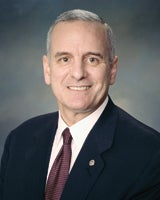Dayton ups tax relief, school spending in budget
Published 9:45 am Wednesday, March 18, 2015
ST. PAUL — Dismissing a Republican push to fully reimburse Minnesota’s $1.87 billion surplus, Democratic Gov. Mark Dayton proposed a revised budget plan Tuesday he said would do more good for the state’s economy by investing in college students and families with school-aged children.
Dayton’s revisions were made possible by the state’s enlarged projected surplus, which climbed by almost $900 million from the time he produced his initial two-year budget in January. He would parcel out all but $13 million, with more money going for nursing homes, welfare grants, preschool programs and college aid and for tax relief targeted at lower-income families.
When his original plan and the rework are combined, Dayton directs roughly half of the surplus to education initiatives.
He contrasted it with the “give it all back” TV ad campaign by the state GOP campaign, which says every resident is entitled to a $350 slice.
Dayton said those types of tax cuts are like M&Ms candy, giving people quick satisfaction but leaving them no better off in the long run.
He added, “$350 might make our lives a little better for a little while. I’d rather invest it to make our lives better for a long while.”
The governor acknowledged his proposal is probably the “high-water mark” in a budget debate still in the early stages. He said he expects a Republican-led House and Democratic-controlled Senate to whittle down his spending recommendations to make room for their own priorities, openly admitting to strategically positioning himself ahead of the true negotiations in May.
Highlights of Dayton’s plan include:
$235 million more to give every 4-year-old access to a tuition-free preschool program.
$174 million to help the University of Minnesota and the Minnesota State Colleges and Universities system freeze undergraduate tuition for another two years and $20 million for an increase to student grants.
$83 million to expand the working family tax credit for 287,000 families.
$68 million to increase monthly payments to families with children in the state’s welfare program by $100 per month, the first such increase since 1986.
$11 million in additional K-12 education tax credits that families can use to offset the cost of textbooks, tutoring, computers and transportation.
Even with the extra spending, some groups fighting for more money got left out. It didn’t contain any new allowances for local governments, which Dayton said would be helped if a separate transportation finance package passes. Advocates for care workers who tend to the elderly and disabled living at home said they were stunned to be excluded even as Dayton proposed $25 million to increase salaries for nursing home workers.
House Speaker Kurt Daudt said Republicans would offer a budget framework next week that broadly says where money would go, with the line-by-line details to be filled in later.
He said the plan would devote far more to tax cuts than the roughly $200 million Dayton has proposed. In January, Dayton called for $100 million to expand the child and dependent care tax credit.
“If we’ve collected too much, let’s make sure that we’re not collecting too much. And let’s make sure they see the fruits of their own labor,” Daudt said, adding that tax exemptions for Social Security income and veterans benefits are high on the priority list.
On Monday, Senate Majority Leader Tom Bakk said the budget plan from his side would be more restrained in case a recent economic uptick tapers off. There are already signs of concern given last week’s mass layoff at Minneapolis-based Target Corp. and idling of taconite plants on the Iron Range.
“We will leave more on the bottom line,” Bakk said.




